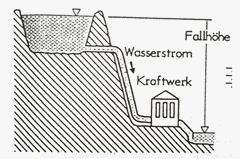Basics of electric current.
Eletric current describes the flow of moving electrons. A water powerplant can be used as a metaphor to better understand how electricity works.
Similar to water, electrons can't flow without pressure.
Voltage - Spannung
Described by the diameter of the pipe (amount of electrons able to pass through). Electrons always move from a higher to a lower voltage, like water flowing from higher to lower pressure.
Voltage is measured in Volt (V) and written as U in formulas.Amperage - Stromstärke
The flow rate at which electrons pass through the 'pipe', like water flowing faster the larger the height difference between the source and the destination. Measured in Ampere (A) written as I in formulas.
Power - Leistung
The rate at which the turbine at the bottom turns. A higher speed equals more power. Power is measured in Watt (W)
P = U x I
Power (Watt) equals Voltage (Volt) x Amperage (Ampere)
The larger the diameter of the pipe, the more water will reach the turbine.
The higher the pool of water is above the turbine, the faster the turbine will spin.
The diameter of the pipe and the pressure of the water need to be balanced to avoid breaking the pipe.
Alternating Current - Wechselstrom
An electric current that periodically reverses direction and changes magnitude continuously.
Used in household appliances and can be transported almost losslessly.
Direct Current - Gleichstrom
One-directional flow of electric charge. Used in solarpanels and batteries. Needs a rectifier (Wechselstromrichter) to convert the current to be used for household appliances.
